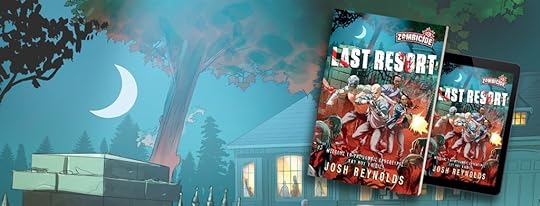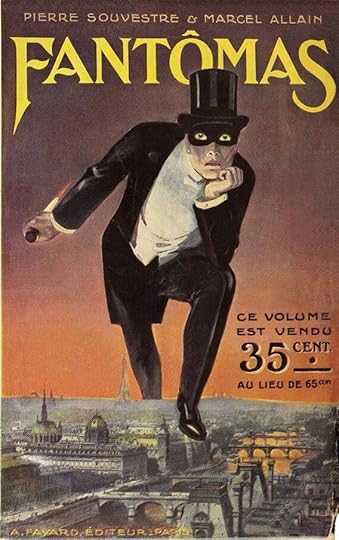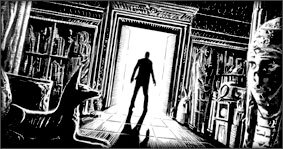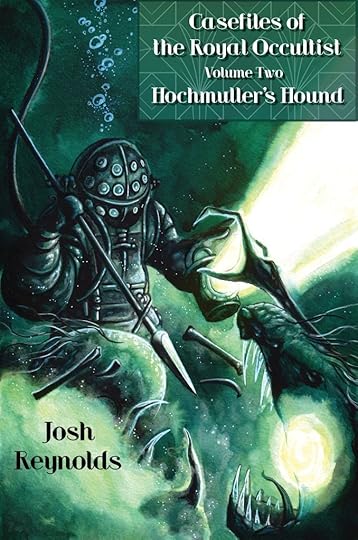Joshua Reynolds's Blog, page 12
February 17, 2022
Last Resort Out in UK Paperback

Last Resort is now available in paperback in the UK! From the blurb:
Hordes of zombies threaten to wipe out all of mankind in this first action-horror novel set in the exciting (yet horrifying) world of the Zombicide games.
The zombie apocalypse has driven humanity up into the Adirondacks. Enter Westlake, a hardened career criminal on the path of “the Villa”, a legendary mafia hideout where he can escape the devastation. When he’s ambushed by the undead, an old FBI “friend” and his squad of survivors rescue him… and then force him to reveal his secrets. The jokey myth of the Villa suddenly becomes salvation for the settlements scattered around Saranac Lake. Reluctantly, Westlake is saddled with an oddball team to navigate minefields, trip wires, and flesh-eating zombies at every turn to find their safe haven. Shame there’s already someone living there…
To learn more about Last Resort, be sure to check out the Aconyte Books website!
February 16, 2022
Flower Path Available for Review

The Flower Path, the newest instalment of the Daidoji Shin Mysteries is available to request for review now on NetGalley. From the back cover:
Extraordinary detective Daidoji Shin returns, in a wonderful locked-room murder mystery like no other, in this lively novel from the epic fantasy world of Legend of the Five Rings
Opening night at the Foxfire Theatre is set to be a huge success for Daidoji Shin, amateur detective turned theatre impresario. The City of the Rich Frog’s leading lights are all there, but even as the performance begins, the Three Flower Troupe’s new lead actress is found dead backstage – and everyone in the venue is a potential suspect. Shin has only till the curtain falls to find the killer. But the clock is ticking and Shin can only hold the great and the good hostage so long. As the night wears on, the chance of the murderer escaping justice grows ever more likely.
To learn more about The Flower Path, and the Daidoji Shin Mysteries, be sure to check out the Aconyte Books website!
Gentlemen Adventurers
Today’s look at the history of the office of the Royal Occultist focuses on the decades leading up to the Great War, and the exploits of Beamish, Drood and Carnacki.
Aylmer Beamish’s time in office was a turbulent one. He opposed numerous horrors in his time, including the Creeping Man, Indrid Cold, the Black Rabbits of the Peathraichean Raidan and the infernal Sebastian Melmoth. He also purchased the house on Cheyne Walk that was to become the official residence of future Royal Occultists, ostensibly on the advice of a ghost.
In 1878, Beamish confronted a resurgent Order of the Cosmic Ram, and made the acquaintance of one of their junior members, Sir Edwin Drood. Scientist, philosopher and extrasensory talent, Drood was a modern renaissance man with a reputation for investigation into the paranormal. It is unknown why he agreed to become Beamish’s assistant, given his obvious distaste for the dissolute occultist. All that is known for certain is that the two men cemented their alliance during an investigation into a series of unnatural events surrounding the Woolwich Pier Disaster.
The partnership between the two men lasted for close to a decade until Beamish’s disappearance beneath the streets of London. Drood’s assumption of the duties of the Royal Occultist brought a return to respectability in the eyes of many – especially Drood’s former compatriots in the Order of the Cosmic Ram. Unfortunately for them, Drood showed little interest in serving old masters. Instead, he turned his attentions to codifying and extending his remit, forming links between his office and those of similar organisations, including the London Tunnel Authority.
During his tenure, Drood made great strides in recording and cataloguing his various encounters with what he called the ‘ab-natural’, including his encounter with the vampiric invader calling himself Dracula and the malign tulpa known as Hyde. Drood also anonymously disseminated that information to the public through the works of friendly writers such as Robert Louis Stevenson and Bram Stoker.
He was an early patron of the Society for Psychical Research, the London Spiritualist Alliance, the Ghost Club and a dozen others, working alongside notables such as Sir Arthur Conan Doyle and AA Watts. It was through these societies that he came into contact with the young occultist, Thomas Carnacki.
Carnacki quickly proved himself indispensable, aiding Drood in his investigations at the close of Victoria’s reign. It was due to Carnacki that fictionalised versions of Drood’s exploits filled the pages of several popular periodicals, though Drood himself disapproved of what he viewed as sensationalism. Regardless, the two men worked well together, and Carnacki soon learned all that Drood had to teach him.
But like his mentor Beamish, Drood vanished at the close of the nineteenth century. Drood had become withdrawn and taciturn in the months prior to his disappearance, as if burdened by some great secret. It is said he secreted himself in a garret in Soho, taking no visitors for several days before eventually vanishing without a trace from the locked room, leaving behind only a set of cryptic notes and a curious jewel of unknown provenance. Carnacki made some attempt to learn what had happened to his teacher, but was eventually forced to give up his quest and turn his attentions to taking up the duties of the Royal Occultist.
Thanks largely to Drood’s foresight, Carnacki’s early tenure was largely uneventful. His investigations into the ab-natural were many and varied, and he continued his associations with the London Tunnel Authority and the Esoteric Investigative Service. The latter was to see its own remit expand during this period, thanks to the tacit support of Carnacki himself, as well as Home Secretary Churchill and other influential figures in the Asquith Government.
By 1912, the EIS had become the Ministry of Esoteric Observation and Containment. What Carnacki thought of this change has not been recorded, though it is known that relations between the office of the Royal Occultist and the Ministry cooled noticeably in this period. It is also during this period that Carnacki became associated with the man who was to become his assistant – Charles St. Cyprian…

February 11, 2022
The Messenger of Evil
On this date in 1911 was born the greatest evil the literary world has ever known. A creature so cunning, so malevolent, that to speak his name is to invite death and destruction. Created on the eve of World War I by writers Marcel Allain and Pierre Souvestre, the monster has had a long life, moving through a number of books, movies, television serials and comic books.
So, to celebrate, I wrote about this ferocious individual. Enjoy!
“Fantomas.”
“What did you say?”
“I said: Fantomas.”
“And what does that mean?”
“Nothing…Everything!”
“But what is it?”
“No one…And yet, it is someone!”
“And what does this someone do?”
“Spreads TERROR!”
– Fantomas, (1911)
Fantomas, the Lord of Terror, the Genius of Evil. Whatever his name, he (or she) is the ultimate archetype of villainy. No crime is too small, no act too depraved for Fantomas to contemplate, to undertake, to accomplish. He made it his mission to destroy the fabric of society for no other reason than that he could.
Put simply, Fantomas is the first super-villain. Born at the dawn of the Twentieth Century, on the eve of the bloodiest conflict the world has ever seen, Fantomas sprang fully formed into a world teetering on the edge of madness. To say that he did his best to push it over said edge is an understatement.
Criminals like Professor Moriarty or Fu Manchu dominated the previous century, spinning Byzantine schemes and matching wits opponents of equal determination, if not skill. Fantomas’ opponents could only scramble to keep up. His schemes were chaotic things, not the precision instruments of his antecedents, but rather a form of madness only recognizable after the fact.
His crimes were outrageous, daring and avant-garde…plague-infested rats released on an ocean liner, sulphuric acid hidden in the perfume dispensers of a famous Parisian department store, or the stripping of the gilded gold from the roof of the Invalides Dome each evening; a man hung by his feet inside a cathedral bell like a human clapper, raining blood, brains and bone down on the masses below, and forcing a judge to witness his own execution by placing him face-up in a guillotine.
Fantomas was everyone and no-one, everywhere and nowhere. A man, a woman, a devil…a phantom. He wielded an army of street-apaches, spies and saboteurs in a calculated effort to spread fear and terror across Europe and the world. There was no purpose to this, save that it was Fantomas’ will that it be done. He was a satanic hurricane, a typhoon of terror, a nightmare without end.
In his wake came a host of imitators and disciples…Satanik, Diabolik, Kriminal, Demoniak, Sadik among others, though none would ever rival the first and most mysterious master of menace…FANTOMAS.

February 9, 2022
Physicians, Thieves and Worse
Today’s look at the history of the office of the Royal Occultist covers the turbulent period between the Glorious Revolution and the early years of what would become known as the Victorian era.
In 1700, Dr. William Coffin, a physician and scholar of some note, was elevated to the position after an undisclosed service to the king. Some say Coffin was responsible for discovering the cause of a mysterious ailment plaguing Queen Mary, while others maintain it was the king himself who was suffering. Regardless, Coffin served at the king’s pleasure until 1714, when he perished in a Wych Street house-fire said to be the result of an elemental conjuration gone wrong – but rumoured to in fact be a personal vendetta by his replacement, Jonathan Wild, the so-called ‘Thief-Taker General’.
Within a month of Coffin’s death, the office was occupied by Wild, who used it as cover for his more esoteric illicit activities. How Wild came to be elevated to the position is unrecorded, though it is not inconceivable that a significant amount of money might have changed hands. Wild’s tenure was marked by the loss of both Rupert’s painstakingly accumulated library and his collection of artefacts – many of which ended up in the hands of private collectors.
Wild was ignominiously dismissed from the position in 1725 for corruption. He was replaced by the mystic and scholar, Henry Balcairn, a former protégé of Wild’s predecessor, Coffin. Balcairn held the post until late 1756, when he was killed during a mystical skirmish with the noted French sorcerer, Henri du Nord.
As the British Empire turned its attentions the developing conflict in the Americas, Balcairn’s assistant, Solomon Woodville, soon found himself despatched to counter certain French efforts in the Province of Virginia. Woodville returned to England in 1762 accompanied by a new assistant, Henry Ebon, but remained only briefly – he and Ebon returned to the Americas in 1764, when they found themselves pitted against the strange creature calling itself Indrid Cold, who was in league with the colonial insurrectionists.
It was a subdued and taciturn Woodville that returned home in 1774 – alone. He never spoke of what had befallen Henry Ebon. Whatever had occurred during his conflict with Cold, it had shaken the formerly sanguine occultist to his core. Woodville retired from public life, and retreated to his family home in Somerset. While he continued to act as Royal Occultist, he did so with little of his former enthusiasm and flair. Woodville died at his home in 1795, a victim of a strange wasting illness.
In 1800, the occultist and philosopher Francis Barrett was invested with the duties of the Royal Occultist. His tenure, while largely uneventful thanks to the proactive efforts of his predecessor, was marked by the sudden appearance of his assistant, the enigmatic Wynn Kardec. Kardec, a virtual cipher, soon became known in polite society as a gambler and serial amorist, as well as for his wit and talent for prestidigitation.
By 1810, Kardec was serving as Royal Occultist, though there is no record of the position being officially bestowed upon him. Kardec served in the position until late 1830, when he is said to have vanished up an Aldershot chimney in a puff of smoke. He left behind a bewildered assistant, Cyril Gorn Yarker, who attempted to pick up where Kardec left off, with little luck.
Yarker’s tenure, while not as fraught as some, ended ignominiously in 1835 when he was lured into an ornamental pond by a mermaid and drowned. He was succeeded by Aylmer Beamish, a rake of some minor infamy. Beamish, purportedly a childhood friend of Queen Victoria (as well as one of the illegitimate children of King William IV), was invested with the duties of Royal Occultist which he was to ably perform for close to fifty years…

February 6, 2022
LATEST NEWS
Below you’ll find all the latest news in regards to Josh’s work, including interviews, appearances and new releases. Check back regularly for updates!
LATEST FREE STORY

This month’s free story has just been posted to the blog!
“The Romero Transference” is a tale of historical Lovecraftian horror that previously appeared in the Chaosium anthology, Atomic Age Cthulhu. As always, it’s absolutely free to read, but if you enjoy it, please consider buying Josh a coffee.
LATEST BOOK TOUR
Aconyte Books is launching its first book tour with The Book Network starting on the 17th of Jan over on Instagram and TikTok. The first in a line of monthly tours starts with CMON Games Zombicide Last Resort, by Josh Reynolds!

LATEST INTERVIEW
Josh sits down with Anjuli to talk about Zombicide: Last Resort!
LATEST NOVEL
Zombicide: Last Resort is Josh’s first foray into the apocalyptic world of ZOMBICIDE. Join Westlake, Ramirez and El Calavera Santo as they battle undead park rangers and worse in the Adirondacks.

The zombie apocalypse has driven humanity up into the Adirondacks. Enter Westlake, a hardened career criminal on the path of “the Villa”, a legendary mafia hideout where he can escape the devastation. When he’s ambushed by the undead, an old FBI “friend” and his squad of survivors rescue him… and then force him to reveal his secrets. Reluctantly, Westlake is saddled with an oddball team to navigate minefields, trip wires, and flesh-eating zombies at every turn to find their safe haven…
Find Out MoreAmazon USAmazon UKLATEST SHORT STORY
“Bruno J. Lampini and the Sanguinary Assignation” is the fourth Bruno J. Lampini story to appear in print, and the wildest outing yet for the amoral acquisitionist of the eldritch!

Enter freely, and drink deeply of fifteen vampire tales told by a sanguinary collection of modern horror authors. Here you will find both traditional vampires, and those who stretch genre boundaries. Not all of these Nosferatu drink blood, but they all share an unholy thirst for human lives. So step into the shadows, and listen for the children of the night.
With Stories by:
Amanda DeWees
Donald F. Glut
John Linwood Grant
Leanna Renee Hieber
Paul McNamee
Chris McAuley
Lee Murray
Josh Reynolds
Cat Scully
Jeff Strand
Plus:
A new Sonja Blue story by Nancy A. Collins
A New Bubba the Monster Hunter story by John Hartness
A New Deacon Chalk story by James R. Tuck
A new Jonathan Crowley/Carter Decamp story by James A. Moore and Charles R. Rutledge
And introducing Renard Duvall in a story by Cliff Biggers
LATEST COLLECTION
Casefiles of the Royal Occultist: Hochmuller’s Hound is the second instalment of a series collecting all of Josh Reynolds’ Royal Occultist stories. This volume features two all-new, never before published stories revealing the first battles between St. Cyprian and the mad Dr. Ptolemy!

From the shattered cities of the western front to the high occult parties of London, a monstrously altered hound stalks.
Dedicated to giving the gods physical form, Dr. Ptolemy builds his own vessels for ancient beings and eldritch terrors.
Only the Royal Occultist can stand resolute against these implacable foes.
Charles St. Cyprian and his assistant, Ebe Gallowglass, defend the British Empire against sinister secret societies, eldritch occurrences, and foul creatures of myth and legend. If there are satyrs running amok in Somerset, or werewolves prowling Wolverhampton, the daring duo will be there to see them off.
Find Out MoreAmazon USAmazon UKFebruary 2, 2022
Shoot an Arrow in the Air
Another bit of interest from my commonplace book. I’ve used this one a time or two in my stories, both licensed and otherwise. It’s a neat visual, and in my opinion, it plays better than the standard card or entrails reading scene.
Belomancy – A sort of divination by means of arrows; the arrows are fired into the air, or at a sacrificial victim, and the future can be read in the pattern of their landing.
January 26, 2022
Cavaliers and Roundheads
Today’s dive into the history of the office of the Royal Occultist covers the extended tenure of Prince Rupert from the fraught years of the English Civil War, to that most ignominious period following the Restoration…
It is unknown what incident marked Prince Rupert’s elevation to the position of Royal Occultist, but he soon proved his aptitude during the Affair of the Buckinghamshire Devil in 1642. With the broken remains of the eponymous devil buried beneath an innocuous field, Rupert set about proving his worth as both a military commander and Royal Occultist in a period of mass chaos, marked by witchcraft and necromancy on an unprecedented scale as dark forces sought to take advantage of the English Civil War.
Rupert’s opponents during this time were too numerous to properly record. Assisted by Dr. Thomas Rudd, Rupert battled an array of menaces, including the resurgent Sisterhood of Rats. Even so, he managed to assemble one of the largest occult libraries in the Occident, as well as a not inconsiderable arsenal of mystical artefacts over the course of his tenure, and he is known to have developed and refined a number of rituals which were used by the holders of the office for centuries to come.
Despite this, his conduct during his tenure was not without blemish. He was said to have used vile sorceries against the King’s enemies on no less than two occasions, once involving the summoning of the ghostly Knights of Gerontius to aid the Royalist cause. It was also rumoured that he had made an attempt on Oliver Cromwell’s life through mystic means, leading to the end of his partnership with Rudd, and the beginning of his ill-starred association with the mysterious ‘Lapland Lady’ who was said to haunt his steps, often in the shape of a white dog of unknown pedigree.
But with the defeat of Charles I and the beginning of the Interregnum, the office fell vacant until the Restoration in 1660. Oliver Cromwell, no friend to what he thought of as heathen witchery, officially stripped Rupert of his authority in 1655, though the latter had already been exiled from England in 1646. Rupert soon quarrelled with the Royalist court-in-exile, and decamped to the Germanies, where he is known to have consulted with a certain Baron Vordenburg of Styria on the matter of the Devil Ferenczy, as well as the Circus of Night.
In the meantime, Rupert’s former assistant, Rudd, was called upon by the Parliamentarian government to act as an advisor on matters of the arcane – though not given the title of Royal Occultist. Rudd, elderly and ill, served in this capacity reluctantly and only for a few months before he was replaced by antiquarian, alchemist and politician, Elias Ashmole. Ashmole’s tenure was largely uneventful, as Ashmole mainly concerned himself with various alchemical experiments. During this time, the mystical defence of England was left to a variety of cunning men, oracles and dour Puritan adventurers.
In 1660, following the Restoration, agents of the Order of the Cosmic Ram convinced Ashmole to step aside, allowing Rupert to reassume the duties of the Royal Occultist. But weary and disinterested in furthering the schemes of his benefactors, he soon resigned in favour of his former apprentice, the aptly-named John Cadmus. Cadmus, a former soldier, was one of several assistants employed by Rupert during this period, but by 1674, he was the only one who remained in Rupert’s good graces. Unfortunately for Cadmus, his tenure was fraught from the start.
While the Order of the Cosmic Ram had largely supported Rupert’s tenure, they did not approve of his replacement. Cadmus often found himself stymied in his investigations by the very people he was attempting to help, or worse – attacked by assassins in the pay of the Order. Because of this, Cadmus was never able to take on an assistant, ensuring that the burdens of his position were his alone.
Finally, after a notable encounter with the Sisterhood of Rats on the eve of the Glorious Revolution, Cadmus went missing and was presumed dead. Whether his disappearance was due to the Sisterhood or to the machinations of Order of the Cosmic Ram, is unknown. In the aftermath of William of Orange’s ascent to the throne, the post of Royal Occultist was left vacant once more, this time for a decade…

January 18, 2022
The Ghost Breaker
John Bass was the first character I ever wrote more than one story about. Inspired by Manly Wade Wellman, among others, I wanted to create a character that I could use to explore a world of my own creation – namely, Jackapo County. I haven’t written much about him of late – I have other characters and other worlds to explore – but I hope to return to him someday, if only for one more story.
Either way, here’s a little something I wrote about him. See what you think.
John Bass is a name known from one end of the county to t’other. Sometimes folks curse it, oft-times they give it a bit of a blessing, but under the tongue, y’understand. All except for Mr. Chicken, who tends his grave because there’s no one else to do so.
John Bass was born in the county and he died here too, which is probably a metaphor for something but I’m not sure what. Either way Bass didn’t hold with metaphors. School neither, but that was his only bias.
Bass left the county as a boy and went to Cuba with Mr. Roosevelt and them, fighting the Spanish. Damn near as soon as he came home, he was gone again, fighting the Germans, though he didn’t hold either group in any particular ill-regard. He was a good soldier as things went but there were stories about him even then. The soldiers under him said Bass had a little bag with a bullet in it and it was the bullet with his name on it so he could never die by violence. They said he’d spit in the Devil’s eye one dark night in a French chapel and that he’d gotten the scars on his hands, big, white looping things, from where he’d fought a dead thing that came slam-bang out of a trench wall one bad day, beating it back into the earth with barb-wire wrapped fists.
They said he’d taken up with a French lady with a monkey on her shoulder and murder in her heart, but that he brought a different lady home-a pretty farmgirl with a shrapnel scar on her face that ran from hair to jawline. They had married and come home to Jackapo County and that’s where the stories got wilder and darker. His wife died of the influenza and his land went sour, a curse they said, on account of the Devil and the spitting and such, and then came that bad black day when he was called up to Jack-Town and he went into that dark house and did what had to be done because there was no fool else to do it.
That’s how John Bass became the Ghost-Breaker. And he broke a hundred of them, if he broke one. He settled Raggedy Fale back in his grave, they said, and saved them babies’ souls. He threw bad, dead Heath Bradley back down into his well and he even went to the Screaming Place and lived, though he was never the same afterwards. But who would be?
And then he died. There’s a story about that too. About how and where he died and what was found around him the next morning. And how he took back the invitation to Tenebre and trapped the Devil there for all that it cost him everything, in the end. But nobody tells the story. No one want to think about Tenebre, y’see.
It was his heart, they said. It just gave out on account of things. But most folks know that’s foolish and they know why he was buried at the crossroads to Tenebre, alongside his foreign wife. And how if you don’t take fright and you go there, to that crossroads at midnight, you can hear the Ghost-Breaker’s heart still thumping and smell the hint of his wife’s French perfume.
And you can know you’re safe there, if anywhere.

January 12, 2022
Mortlake and After
Today’s delve into the secrets of the Royal Occultist is the first part of an oft-requested series – the full and true origins of the office of the Royal Occultist, and its many occupiers, from its humble beginnings to its rather abrupt end. The first entry covers the fraught early years of the office.
The office of the Royal Occultist has its origins in the reign of Queen Elizabeth I of England. The first to bear the title was the infamous Sage of Mortlake, Dr. John Dee. Dee, alongside his assistant, Edward Kelley, earned Elizabeth’s patronage after his investigation into a case of witchcraft involving a poppet made in the queen’s likeness. The pair went on to confront various supernatural threats to the crown before an unspecified occurrence in Bohemia brought a sudden end to their partnership.
Returning to Mortlake after the Bohemian incident, Dee found his home vandalised and his occult library ransacked by a person or persons unknown. Some whispered that the culprit was Edward Kelley himself, while others blamed Dee’s rivals at court or secret societies such as the nascent Order of the Cosmic Ram. Dee himself ventured no opinions on the matter – at least not publicly – and resumed his duties with a new assistant, one William Sly – an aspiring thespian and former spy.
Dee continued to act as Royal Occultist until his death of natural causes in 1608 or 1609. Despite William Sly having preceded Dee in death, the office did not remain vacant for long. In 1610, King James I, concerned by the possibility of supernatural threats to his rule, invested a man named Subtle with the responsibilities of the office. Subtle, who claimed to have learned at the feet of ‘Aegyptian masters’, was more proactive than his predecessor. Armed with a royal charter by the king, and aided by the mystic, John Lamb, he faced down numerous eldritch menaces in the years following his assumption of the post, including a persistent coven of Scottish witches known as the Peathraichean Raidan, loosely translated as the Sisterhood of Rats.
Regrettably, Subtle fell out of favour with the king in the waning years of James’ reign, and was dismissed from the post in 1620, to be replaced by a succession of influential noblemen, none of whom were remotely familiar with the occult sciences. The names of these interim holders were not recorded for posterity, the longest tenure being a scant six months. It is said, however, that Subtle continued to act on behalf of the country, if not the Crown, until his death by spontaneous conflagration in 1627.
Charles I, James successor, did not share his predecessor’s interest in the supernatural, and continued the practice of bestowing the office of Royal Occultist onto whomever had his favour at a given moment, whether they were up to the task or not. Of the dozen men who held the post between 1625 and 1642, only one name stands out – Edward Holywell. Alchemist, marksman and member of the secretive Order of the Cosmic Ram, Holywell was the most effective of Charles’ early appointees, taking up the duties in 1630. Together with his assistant, Whitehead, Holywell served as Royal Occultist until 1640, when he was killed by the hexed bullet of a Peathraichean Raidan assassin.
The office was to remain vacant for nearly two years, until the king’s nephew, Prince Rupert of the Rhine, arrived in England…




